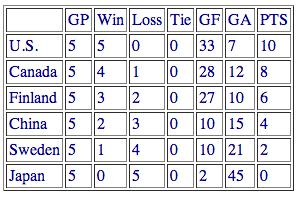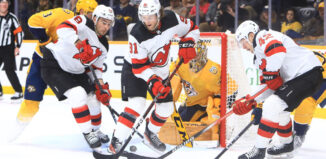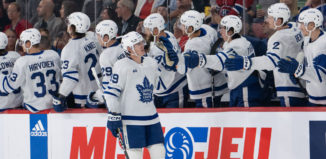Olympic Women’s Hockey: Why Gold Matters
(The American team celebrates the historic, first women’s Olympic gold in Nagano in 1998. Source: .www.iihf.com)
What is the pinnacle of an NHL athlete’s career?
This isn’t a trick question. Your brain probably just said, “Winning the Stanley Cup,” and your brain is right. Awards are nice feathers in a player’s cap, maybe nice incentive for a higher salary. But little boys on skates don’t grow up dreaming about winning an ESPY or even an Art Ross. Little boys grow up dreaming about Lord Stanley, hoisted high over their heads, to the roar of a home crowd. They dream about their names, etched and permanent in tiny script along its rings, a stamp that says I was here and I did this. They dream about bringing that beautiful, carved promise back to their hometowns and letting their neighbors put babies in its mouth as summer peaks and cools and then fades again into the new season, into the first breath of their skates back on ice.
Here’s another question: What do little girls on skates dream of?
—
The first Olympic tournament to include women’s hockey took place in 1998 in Nagano, Japan. The International Olympic Committee (IOC) had voted to approve the inclusion of women’s hockey as early as 1992, but it was nearly left out of the 1998 games as the Nagano Winter Olympic Organizing Committee felt, not unreasonably, that the costs of hosting the event was an unfair additional burden (given that women’s hockey had not been in the program when they made their bid and were granted the honor of hosting). Eventually they agreed, but with the stipulation that only six teams would be allowed to compete, no additional facilities would be built, and the Canadian Amateur Hockey Association would help build and train the Japanese team.
The six teams to show up that year were the United States, Canada, Finland, Sweden, China, and Japan. Canada was the heavy favorite to win, having taken home literally every international championship up to that point. The IIHF World Women’s Hockey Championship held its first tournament in 1990 and Canada won every single one of its gold medals until 2005, with a quick break in 1995 and 1996 when the World Women’s Hockey Championship became the Pacific Rim Championship. (They won those, too.)
Mostly the United States rode into and out of World Championships on silver; they came close to gold, in 1997, losing 4-3 in overtime. Finland stayed comfortable in third place for the first ten years of the Championship (Russia would oust them in 2001). And though Sweden most frequented the fourth place spot, China had bested them twice, in 1994 and 1997.
Everyone knew what the Games’ outcomes would be. Canada would win, because women’s hockey–what there was of it–and there wasn’t much–belonged to Canada. The United States would place second, as they always did. Third place was a bit of a toss up, maybe. Finland? Sweden? Probably not China. Almost definitely not Japan.
The thing is … everyone was wrong.
Round Robin Points Tally
Olympic Women’s Hockey, 1998
 (source: whockey.com/int/olympics/1998)
(source: whockey.com/int/olympics/1998)
They were wrong in the Round Robin Canada/U.S. match-up, when the American team somehow managed to claw their way back from a 4-1 deficit to a 7-4 win. They were wrong in the final, when the United States held a 3-1 lead through the final buzzer. They were wrong when 20 non-professional women became just the third American hockey team of any gender to take that gold medal home.
(Well, they were right about one thing. Third place was definitely not Japan.)
—
If you are eighteen, and you are a girl, and your feet fit better in bulky black skates than they ever did in elegant white ones, here are your options:
- College hockey.
Well, that’s unfair. The Canadian Women’s Hockey League (CWHL) exists, and has six teams who battle every year for a spot in the Clarkson Cup Championship. The Western Women’s Hockey League (WWHL) also exists, except that is supposed to have merged with the CWHL in 2011.
Let me be clear: the CWHL is an excellent league, filled with excellent players, both past and present. Julie Chu is the obvious example, but there are also hockey greats, both past and present, like Manon Rhéume, Caroline Oullette, Ding Xiaolin, and Lori Dupuis. The talent is there, all there, so obviously, frustratingly there.
The money is not.
In 2013, the entire league was operating under a budget of $1 million. To give you a frame of reference, the NHL’s minimum salary is $525,000. That is to say, a rookie who has never played a single NHL game will make 52.5% of the CWHL’s entire budget. None of the players are paid; the coaches are, but their salaries are “roughly equivalent to what [someone] could make flipping burgers at McDonald’s,” according to a Boston Globe article about the Boston Blades which ran on March 21, 2013. The league spreads its money equally across the teams, most of it going toward travel and equipment.
Trina Crosby, mother to Pittsburgh Penguins captain Sidney, made headlines earlier this year when she joined the board of the CWHL for the 2013-2014 season. When asked what had prompted her to become involved, she told a story about her 17-year-old daughter Taylor, a goaltender at Shattuck-St. Mary’s. (Hockey Canada seems to think that she’s pretty all right, if their invitation to a prospect camp in Calgary is any indication.)
As Mrs. Crosby told The Star:
“She started talking about how much she loved playing hockey … She said it’s scary to think she’d have to give it up and it wouldn’t be part of her life. I said, ‘What do you mean?’ and she said she’d go to college and university and then what? What after that?”
What after that, indeed.
The overall style of women’s hockey is not the same as men’s hockey; its strengths and strategies have evolved into something unique. Men’s hockey is fast, but women’s hockey is fluid. Men’s hockey is brash, and women’s hockey is a little bit sneaky. That’s not to say that women couldn’t play the hard-hitting hockey of the NHL–one look at the Lamoureux sisters in action proves that. Nor is it to say that the NHL is all fist and no finesse. But watch an NHL game immediately after a CWHL game and the differences are apparent.
“If there’s a better hockey player in the country [than Amanda Kessel], I’d like to know who it is,” said Minnesota coach Brad Frost to United States College Hockey Online in January of 2013, as quoted in the Toronto Star. The Hockey News ranked her as the 8th best hockey player of 2013–the only woman on the list but certainly not the only one who deserved to be there. If performances by players like Amanda Kessel, Hayley Wickenheiser, Noora Räty, and so many others are any indication, women’s hockey is a bastion of smart, strong, dedicated skaters with hockey sense that is, frankly, out of this world.
You have to be dedicated to play women’s hockey. There aren’t any incentives to do it, beyond a desperate love of the game.
—
When the triumphant USA Women’s Hockey Team returned home from Japan in 1998, USA Today ran a piece on their welcome home. It included a charming and poignant reference to the fact that only 15 of the 20 players were featured on the Wheaties cereal box (one-and-a-half million boxes of cereal!), because five of them were college students whose involvement with NCAA sports precluded them from appearing in promotions. The hockey team was chosen over other female heroes because, according to the article, they had given “the most memorable performance of the Winter Games.”
It also included this:
PIONEERS LOOK AHEAD: One will finally go on her honeymoon. Another may travel with her best friend and Olympic rival. The rest will return to the educations or careers they postponed. Whatever they do, now that gold medals hang around their necks, things will never be the same for the U.S. women’s hockey team – or for any other girl or woman who loves the game.
It’s a paragraph that hurts in how much it still rings true. The gold medal still means everything to women’s hockey; it still has to. In a league where tickets are often on sale for as little as $10 (free, if you’re under the age of 6), it is the closest that many will ever get to a roaring crowd. Competing and finding success at the Olympic level is an enormous accomplishment, requiring hours and hours of practice, travel, sweat, and sacrifice. For the men, a spot on the roster means a trip to the Olympics while the NHL waits; for women, it means tours and tournaments and time spent with players who are as much your teammates as whatever team you play for back home.
This is true of any Olympic sport, not just women’s hockey; but it means something different to a sport where, from the moment you step down from that raised podium, you’re left as part of a league-wide question mark.
In 1998, coming off the win from the Olympics, plans were made for a Women’s Professional Hockey League. Members of the gold medal winning women’s hockey team, such as Katie King, were said to be involved with the project.
Ed Saunders, president of the organization, wrote:
We are not trying to be a WNHL. The model we have used falls more along the lines of men’s major junior hockey in Canada. Unfortunately, no such program exists for the world’s finest women’s hockey players. As a result, many have indicated that after the Olympics, they will retire. They will leave the game that has been so important in their lives thus far. Ask yourself, what message does that send to the thousands of young women and girls out there that may choose to participate in women’s ice hockey? If you’re not one of the fortunate 20 to make the national squad in your country, where do you go to compete after college? Where do you train for the 2002 games? I know several world class players who are unexpectedly facing those questions on a daily basis right now.
But money proved an issue–just as money is always proving an issue in women’s sports–and the league never quite materialized. Players on the men’s teams will fly home and get back to their seasons and their salaries and their Stanley Cup runs. And all the verve and spark and talent, all that blade-sharp hockey sense and devastatingly quick hands of the Olympic women’s hockey teams, will be left asking, “And then what?”
What after that, Mom?
A gold medal is women’s hockey’s own version of I was here and I did this. There won’t be a Cup day, but there will probably be a parade. There will be the moment when the whole world understands that figure skates gave them blisters that didn’t hurt right, not the way that hockey blisters did.
What do little girls on skates dream of?
Gold.














[…] was an amazing article posted at The Pink Puck about the importance of the gold medal to women’s hockey players. […]
[…] country competition for a medal, and medals are, of course, important. For some athletes it’s the only tangible glory they can achieve to recognize a peak in their […]
[…] hockey; she is retiring because there is nowhere for her to go. I wrote earlier this week in “Women’s Olympic Hockey: Why Gold Matters” about how limited a woman’s hockey options are, the farther along she gets in her […]
[…] hockey; she is retiring because there is nowhere for her to go. I wrote earlier this week in “Women’s Olympic Hockey: Why Gold Matters” about how limited a woman’s hockey options are, the farther along she gets in her career. […]
This is a great piece and it hits right on what I was trying to get across to someone who was incredulous that I don’t really have the same passion for team USA in Olympic men’s hockey as I do for them in Olympic women’s hockey. This is all we have in women’s hockey, all that the world cares about, the only team that little girls who play hockey can really identify with and dream about becoming a part of. The USA men’s team will come back and rejoin their teams and get paid millions of dollars to pursue the Stanley Cup. The women will come back home and maybe coach, or some will resume their college careers, run hockey camps, try to find jobs tangentially related to hockey and….try to find time to train as well. Sorry if I care more about the players for whom it means more.
[…] can read some fantastic articles on the CWHL like this one at The Pink Puck, or this one on the Kessel Divide at Stanley […]
[…] last year’s disappointing season. Team USA’s roster, which includes 12 members of the 2014 U.S. Women’s Olympic Team, can be found […]